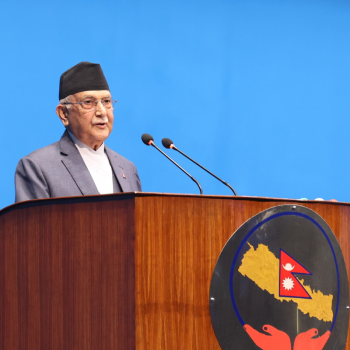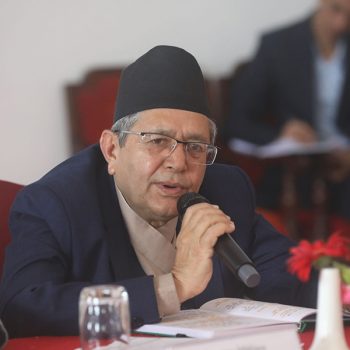The Prospect of Regenerative Agriculture in the Global and Nepalese Context

Introduction
The era of chemical-intensive farming using synthetic farm inputs and agro-chemicals for boosting food production is gradually losing traction worldwide and instead a new wave of agricultural movement is beginning to emerge and gain increasing momentum in recent years. This new method of farming is given the term “regenerative agriculture.” As the name goes, the idea behind such a movement is triggered by the need of the farming communities to lower their farm input expenditure, by helping farmers lessen their growing dependency on commercial fertilizers and pesticides, while at the same time able to grow enough food to feed the world’s growing population in a sustainable way.[1]
The failure of industrial farming and the search for an alternative model
Industrial farming which places heavy reliance on continuous application of external farm inputs such as synthetic fertilizers and inorganically derived chemical pesticides has dominated the agricultural landscape worldwide, more specifically in the western developed nations for more than a century. In its wake, such chemical-intensive ways of food production have left a trail of destruction on major environmental and ecological indicators worldwide, including crisis in human health, while exacerbating degradation of farmland, contamination of water bodies, and loss of biodiversity.[2]
Many farmers after having practiced and endured chemical-intensive and large scale monocropping with the application of industrial farming methods for decades, seemed to be frustrated with the results, because their soil is giving up, farm productivity is declining, and farmers are not making enough money from agriculture to pay their loans and debts.[3]
As the price of factory-manufactured synthetic agricultural inputs has remained uncertain and volatile in the global market with skyrocketing prices of the same in recent times, farming occupation has added an extra layer of burden and mental stress to the farming communities, especially those practicing commercial farming and commodity-based agriculture.[4] This trend is palpable because chemical-intensive agricultural commercialization on larger farms demands huge capital investment from farmers, requiring them to purchase heavy tractors, farm equipment and agricultural machinery, alongside the need to maintain expensive irrigation infrastructure in place. Such capital-intensive farming with considerable initial investment from farmers often tends to overrun or exceed the anticipated economic returns, making such an approach to agriculture less promising and viable.[5,6]
The quality and nutritional value of food produced from such chemical-intensive monocultures is further questionable on health grounds raising concerns among many consumers and health-conscious souls.[7]
Furthermore, an overwhelming number of research studies in recent decades have conclusively shown that chemical-intensive agriculture is not only untenable but also unsustainable to meet the growing food demands of the ever-increasing world population.[2,8,9,10] For instance, according to FAO report (2024), 733 million people worldwide are still confronting chronic hunger issues from lack of food, while 2.33 billion people – comprising 29% of the global population are facing food insecurity due to limited food access.[11] Such problems of food shortage and its inaccessibility is often seen in poor communities and among marginalized farmers who either lack the purchasing power to procure food to feed their families or are withheld from land ownership rights to grow their own food, compounded by other factors.[12] As such, the initial promise of industrial agriculture, and its purported ability to grow enough food in large mono-cropped farms to feed the growing human population for helping them overcome chronic food shortage and global hunger problem is fading into oblivion and becoming more unrealistic day by day.[5,8]
Farming communities worldwide are therefore in search of an alternative pathway of food production and mainstream policy interventions that protects and builds soil, mitigates the negative effects of climate change, safeguards ecosystem function and biodiversity, while providing food access to the economically underprivileged.[13,14] In other words, such an approach to farming must be regenerative and cost effective both in its philosophical underpinnings and in actual practice.
The promise of regenerative agriculture
One of the fundamental guiding principles behind the regenerative agricultural movement is that its followers recognize and treats soil as a living ecosystem that needs to be protected and conserved, and not simply an inert matter or medium for growing crops, as has often been misunderstood in the past, more so by the proponents of industrial agriculture enthusiasts. Such revelations about our renewed understanding of soil as a living biological entity have been scientifically proven through numerous research findings by soil microbiologists and allied scholars.[15,16,17] At the very least, regenerative agriculture should not only nurture soil health and protect the greater ecological landscape for the long term, but also should provide enough food for many with equitable access to land ownership, to combat world hunger and supply human nutritional needs.[18]
The followers of regenerative agriculture do not limit themselves to only adopting one single farming practice but a suite of land management practices, such as integrated farming, multiple cropping, agroforestry, minimum tillage, plantation of cover crops, permaculture, and other nature-based methods of soil regeneration.[19] The prime objective of regenerative agriculture is to create and nurture healthy soil through accumulation of organic matter and humus, which are the building blocks of life and soil microbial activity. The other promise of regenerative agriculture is its huge potential to combat the impending climate change crisis by its ability to sequester atmospheric carbon and restore it back to earth,[20] to where it originally belongs.
This evolving paradigm shift towards finding a better alternative for feeding humanity by remaining within the environmental boundaries and carrying capacity of nature is indispensable for our existence and survival. In view of this reality, the time-tested philosophy and concept of regenerative agriculture has its roots tied to the indigenous people worldviews that holds humans and nature as inseparable life forces, both having a mutual responsibility to nurture each other for its thriving and sustenance.[21] Therefore, the concept of regenerative agriculture is not new. Mimicking mother nature’s inherent grand design that has supported the mutual coexistence of a multitude of biological life forms for eons while sharing a common living space and environment, and interdependent on each other for food and survival, have been the cornerstone for understanding the underlying philosophy behind the regenerative agricultural movement worldwide.[22] In fact, such forms of benign agriculture, either knowingly or unknowingly, have been practiced for centuries by indigenous communities.[21] before the destructive modern industrial farming start to take shape with the false promise of feeding humanity with sufficient food and nutrition.
In the context of Nepal, adopting regenerative agricultural principles and practices by the farming communities is even more critical given that the country has only about one-fourth of its total geographical landmass that is considered to be arable land suitable for farming.[23] Several research studies have found that Nepal is already losing topsoil and soil organic matter that can sustain agricultural production at an alarming rate in recent decades.[24,25, 26] This is happening due to the adoption of unsustainable farming practices, aside from natural calamities, rapid urbanization, and other anthropogenic factors.[26] Hence, protection of Nepal’s limited land resource while relentlessly improving its productive potential with best management practices that align with regenerative agriculture’s objective and philosophy is vital for securing the country’s food security both in the short and long term.
Final Remarks
Aside from being highly capital-intensive nature of food production with higher risks of failure and diminishing economic returns, the other underlying reason why industrial farming model is losing the interest of farming communities globally is that it has its genesis rooted in maximizing short-term gains only, while disregarding the long-term sustenance of agroecological system[27] – that often have its ability to self-regulate and thrive.
Industrial farming ever since it began its rampage with the high-held promise of maximizing farm yield and feeding the growing human population, start treating agriculture as a profit-maximizing tool by commodifying selective crops and capturing the market share of agricultural products, ultimately leading to the ubiquitous proliferation of ultra-processed foods, excessive consumerism, and waste generation.[28]
The proponents of the industrial farming model seemed to have succeeded very well so far in manipulating science through political lobbying and monetary power backed-up by large agricultural corporations.[29] As the industrial agricultural model and its pathway is mostly benefiting the rich and privileged power structure in society at the cost of many undernourished and the poor class, its farming model continue to break apart the natural process of life formation and soil regeneration, that has been perfected by nature for the last 3.7 billion years, when biological life is believed to have marked its origin on planet Earth.[30]
The central essence of this article can be summed up with the following message: It is easy to fool people and society, but one cannot fool nature. Nature has its own laws and rules to be obeyed. The underlying philosophy of regenerative agriculture seems to flow with the inherent blueprint and deeply rooted principles of nature and its life force, so it holds a high promise to feed the growing global human population while safeguarding our environment.
References:
- Khangura, Ravjit, et al. “Regenerative agriculture—A literature review on the practices and mechanisms used to improve soil health.” Sustainability3 (2023): 2338.
- Tilman, David, et al. “Agricultural sustainability and intensive production practices.” Nature6898 (2002): 671-677.
- Kobayshsi-Solomon, Erik. “Conventional Farming is Killing Us and Our Planet” Forbes (2023). URL: https://www.forbes.com/sites/erikkobayashisolomon/2023/12/06/conventional-farming-is-killing-us-and-our-planet/
- Cordero, Monica. “Farmers Frustrated as Fertilizer Costs Soared in 2022.” Modern Farmer (2022). URL: https://modernfarmer.com/2022/12/fertilizer-companies-cashed-in/
- Montgomery, David R. “Growing a revolution: Bringing our soil back to life. W.W. Norton & Company (2017).
- Union of Concerned Scientists. “The Hidden Costs of Industrial Agriculture” (2008). URL: https://www.ucsusa.org/resources/hidden-costs-industrial-agriculture
- Sarkar, Atanu, et al. “Emerging health risks associated with modern agriculture practices: A comprehensive study in India.” Environmental research115 (2012): 37-50.
- Anderson, J., Hespeler, E., & Zwiren, S. “Monocultures in America: A system that needs more diversity.” (2017). Debating Science. https://blogs.umass.edu/natsci397a-eross/monocultures-in-america-a-system-that-needs-more-diversity/
- DeLonge, Marcia, and Karen Perry Stillerman. “Eroding the Future: How Soil Loss Threatens Farming and Our Food Supply.” (2020). URL: https://www.ucsusa.org/resources/eroding-future
- Dimitri, Carolyn, Anne Effland, and Neilson C. Conklin. “The 20th century transformation of US agriculture and farm policy.” (2005).
- Payne, Hannah. “2024 FAO Report: 733 Million People Face Hunger – Here’s How You Can Help” Rise Against Hunger (2024). URL: https://shorturl.at/FqgQr
- Sen, Amartya. “Poverty and famines: an essay on entitlement and deprivation.” Oxford University Press (1982).
- Azadi, Hossein, et al. “Rethinking resilient agriculture: From climate-smart agriculture to vulnerable-smart agriculture.” Journal of Cleaner Production319 (2021): 128602.
- Ikendi, Samuel. “Ecological conservation, biodiversity, and agricultural education as integrated approaches for envisioning the future of sustainable agriculture in North America.” International Journal of Sustainable Development & World Ecology2 (2023): 152-163.
- Semenov, A. M., and E. V. Semenova. “Soil as a biological system and its new category—health.” Biology Bulletin Reviews8 (2018): 463-471.
- Silver, W. L., et al. “The role of soil in the contribution of food and feed.” Philosophical Transactions of the Royal Society B1834 (2021): 20200181.
- Ohlson, Kristin. The soil will save us: How scientists, farmers, and foodies are healing the soil to save the planet. Rodale Books, 2014.
- Rhodes, Christopher J. “The imperative for regenerative agriculture.” Science progress1 (2017): 80-129.
- Khangura, Ravjit, et al. “Regenerative agriculture—A literature review on the practices and mechanisms used to improve soil health.” Sustainability3 (2023): 2338.
- O’donoghue, Tom, Budiman Minasny, and Alex McBratney. “Regenerative agriculture and its potential to improve farmscape function.” Sustainability10 (2022): 5815.
- “The Indigenous roots of regenerative agriculture.” Rainforest Alliance (2023). https://shorturl.at/t1VB3
- White, Courtney. “Why regenerative agriculture?.” American Journal of Economics and Sociology3 (2020): 799-812.
- Nepal – Agricultural land area. World Bank Atlas (2021). URL: https://knoema.com/atlas/Nepal/Agricultural-land-area
- Joshi, Prayon, et al. “Himalayan watersheds in Nepal record high soil erosion rates estimated using the RUSLE model and experimental erosion plots.” Heliyon5 (2023).
- Chalise, Devraj, Lalit Kumar, and Paul Kristiansen. “Land degradation by soil erosion in Nepal: A review.” Soil systems1 (2019): 12.
- Raya, Balaram. “Soil erosion and environmental degradation in Nepal: A Review of Environmental Policies.” The Third Pole: Journal of Geography Education(2023): 15-29.
- Alexander, John. “Environmental sustainability versus profit maximization: Overcoming systemic constraints on implementing normatively preferable alternatives.” Journal of Business Ethics2 (2007): 155-162.
- Patron-Cano, Gerardo. “Modern capitalism and food commoditization: The limitations of industrial agriculture and the challenges of sustainable alternatives.” MS thesis. University of Denver, (2015).
- Sebastian, Kyle, A. “Lobbying to influence Legislation Including Farm Bill Tops $500 Million.” Union of Concerned Scientists (2024). URL: https://www.ucsusa.org/about/news/agribusiness-industry-lobbying-exceeds-500-million
- Ricardo, Alonso & Szostak, Jack W. “The Origin of Life on Earth.” Scientific American Magazine. 301.3 (2009). URL: https://www.scientificamerican.com/article/origin-of-life-on-earth/
About the Author:
The contributor of this original article is a research scholar at the University of Illinois at Urbana-Champaign, U.S.A. and holds a Ph.D. in Natural Resources and Environmental Sciences. The author could be reached through his email address at [email protected] or [email protected]. The author could be contacted via his website https://sharmasuresh.com/ as well.









